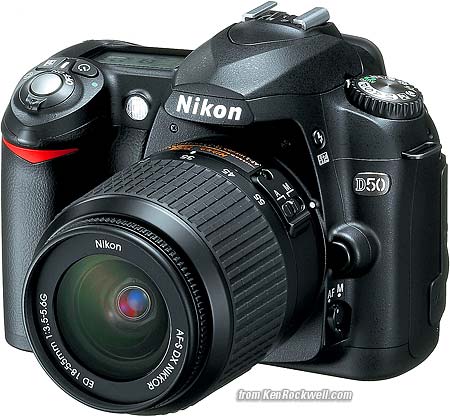How
to Use the Nikon D50
© 2006 KenRockwell.com
About
these reviews

|
|
D50 with 18 - 55 mm. I'd get it here or here. enlarge
SET UP MENU (wrench icon) back to top
Select the Set Up menu by pressing MENU and selecting the wrench icon.
Format: this how to format a card. Professionals always reformat a card every time it's put back into a camera to prevent any potential for card errors.
CSM Menu/SetUp: As I've suggested, set this to Detailed to get the complete Custom Settings Menu. Otherwise you only get a few custom settings.
DATE sets the time and date.
LCD Brightness sets the viewing angle for the LCD, not necessarily the brightness of the backlight. I leave it on 0. Only play with it if you look at the LCD from odd angles or work in very hot or cold temperatures.
Video Mode sets the format of the video output. Use NTSC (525 lines, 59.94Hz) in the Americas and Japan, and PAL (625 lines, 50Hz) in Europe.
Language: Set yours to Swedish, then see if you can navigate back to English. Fun!
Image Comment: This lets you encode a secret text message into every file. Mine is set to (c) KenRockwell.com with my phone number! You see this text looking at the EXIF data in software on a computer. Our Japanese friends have still not provided us with a real © symbol here.
You set this by going to MENU > Setup Menu (wrench) > Image Comment > Input Comment > (add your message like you did on 1970s video games) > Enter. If you forget to hit ENTER the Japanese will have a laugh on you, since you have to start over. So sorry!
When you get your text message spelled out, go to Attach Comment and hit SET so a small checkmark shows. Now go to and select DONE. If you forget to check Attach it won't attach, and if you forget to hit DONE it will also forget everything you just did. So Sorry! I don't write the firmware.
To edit or remove a character, select it in the Input Comment screen by holding the checkerboard button and spinning the rear control dial. Now press the Trash button to delete, or add a new character with the four-way navigation switch and press the WB/?/key button to add it.
It's great having everything you shoot have your contact info embedded. It also allows you to prove ownership in a third-world country when catching a thief with your camera. Help the cop go through the menus and read your personal ID information.
USB: I leave it at mass storage. Use whichever works better with your computer.
Folders: You can create, select and rename folders on your memory card. Normal people never use this menu. The pro cameras have a trick which creates a new folder if you hold the "?" button on power on, but the D50 has no such automatic feature. It's more of a pain to make new folders than it is to sort the images later from the same folder, so I don't bother.
Select Folder chooses the folder into which new photos are recorded.
New lets you make a new folder and name it.
Rename and Delete are self explanatory.
File Number Sequence: This lets the camera number your images starting at the last shot you made, even if you've formatted your card. I leave this to ON. If you turn this feature off you'll start from 0001.JPG each time, which is stupid. It's stupid because In time you'll have 150 files all called DSC_0012.JPG on your hard drive. You'll thank me when you try to put together a slide show and don't have to rename them all! Also it lets you keep track of how many shots you've made, since it runs up to 9,999 shots before it resets.
Mirror Lock-Up isn't. This setting is used to lock up the mirror to clean the CCD. I never use this, since I find it easier to set the camera to Bulb and hold open the shutter. It's not a lock up for telephoto lenses on tripods.
Dust Ref Photo is used to take a picture of the dust on your sensor. If you pay Nikon another $100 for Nikon Capture software you can use this to erase the dust more easily from your images shot in Raw. You people know who you are. I don't do this!
Firmware Version lets you check the firmware version. This lets you confirm if your camera is up-to-date with Nikons' free firmware updates.
Image Rotation sets a flag in vertical images which keys most software to display the image vertically. It does not actually rotate the images; it just sets a flag. Someday the camera's firmware will work properly and rotate the image itself, but no camera does that yet.
That's It! Enjoy! If you find this as helpful as a book you might have had to buy, feel free to help me write more with a donation. Thanks! Ken.
CONTROLS (every button and knob)
MENUS (every menu item in detail)


